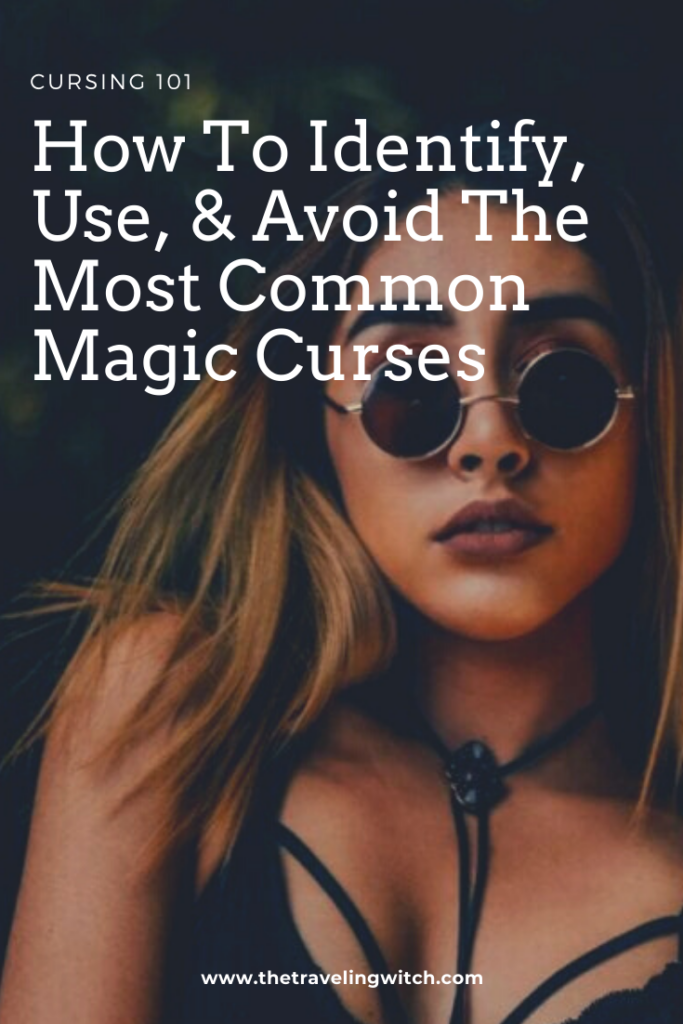This week we’re on to Part 3 of our Cursing 101 series. If you’re just joining us for this series, you can read the first installment here! >> Cursing 101: Part 1
So far in this series, we’ve been focusing on theoretical aspects of cursing. In Part 1 we discuss how to decide if cursing is the correct approach for your situation and we covered some aspects of the ethical debate surrounding the subject. In Part 2, we got a little more hands-on with curse breaking.

Today we’ll be wrapping up the Cursing 101 series and talking about types of curses. Knowing the types of curses that are out there is helpful not only when casting curses yourself but also when trying to break them, so regardless of whether you’re a cursing witch, this information can still come in handy!
Quick Curses
Many curses are too elaborate for use in day-to-day situations or by beginners. I often find that drawn-out curses that may take days or even weeks to perform aren’t always practical. Modern witches don’t always have the time, tools, or energy to perform such curses. While there is certainly a place in the craft for more elaborate forms of baneful magic, it can be incredibly useful to have a few more simple methods tucked away in your back pocket for when you need them. In situations like these, there are quite a few options available to a witch in need of a hasty curse.
Spitting
Spitting is a powerful form of cursing. It takes some effort to work up enough saliva to spit on something while not taking up a terrible lot of time so you can work a lot of intent into one little action. Obviously, spitting on someone would be the most direct form of cursing them, but that’s quite an inflammatory move and is actually illegal. I don’t recommend it. Instead, the caster will more commonly spit in front of or behind the person they’re trying to curse. Alternatively, they can spit on something of the persons, preferably something the target will make direct contact with like a door handle, a car door, or a chair.
The Evil Eye
The evil eye (also called Malochia, being crossed, or eye biting) is a very common spiritual affliction. Some version of this phenomenon is known in nearly every culture, it’s so widespread that it even makes an appearance in the Bible. In essence, the evil eye is an unintentional curse.
This is a very important point, the evil eye is nearly always unintentional! Because of this, the approach needed to remove it is very different from a curse. The evil eye happens when a person who has the ability feels a strong negative emotion, typically envy or jealousy, but also occasionally anger. This intense negative energy is projected onto the person that they’re feeling negatively about through the gaze.
The symptoms of this condition usually begin with a headache. Often a dull ache in the head can follow the encounter where the eye biting occurred within 10 minutes. Sufferers of this condition are also likely to experience fatigue, feeling mentally foggy, or suddenly becoming prone to clumsiness, dropping things, or minor accidents.
Prolonged or repeated exposure to the evil eye can result in more severe headaches or migraines, chronic fatigue, and accidents that become more severe as time goes on. If you can decipher who is casting the evil eye upon you, you can protect yourself from them and relieve this spiritual ailment quite easily.
Getting rid of the evil eye is quite simple. A cleansing bath is ideal but using other cleansing methods might also work. You simply need to remove the negative energy that was thrown at you, because it was not intentional it will be far less resistant to cleansing than an intentional attack would be.
After this, you should take the time to replenish yourself with a positive energy. Play upbeat music, eat food that you love and makes you feel good, go for a walk in nature, or practice any form of self-love that you enjoy.
Finally, using a protective spell or charm to prevent future instances of eye biting is a good idea. If you use an amulet or talisman and it breaks or falls off DO NOT pick it up. This means that it has done its work and has intercepted the evil eye, picking it up can transfer the energy to you. Replace the charm immediately but do not pick up the fallen one.
This particular spiritual danger can be quite unpleasant because the source is often someone close to us. While the evil eye can be cast between any two people it’s most commonly cast between friends, married couples, and parents to their children. This makes repeated exposure quite likely. Most people who have this ability are not aware of what they do, if the person is amicable to this sort of thing you can try to talk to them about it so they can prevent themselves from eye biting in the future but if this is not a possibility then regular cleansing and protection will allow you to maintain a healthy and comfortable relationship with this person regardless, at least on a spiritual level.
Verbal Curses
Quick verbal curses are easy and effective. There are many common sayings and phrases that are really verbal curses and many of them come from cultures with a history of magic and witchcraft. The Irish are particularly well known for this, so if you need ideas, that’s a good place to start. Here are a few examples of verbal curses.
- May you find the bees but not the honey
- The crows’ curse on you
- May the cat eat you, and may the devil eat the cat
- May all your bacon burn
Written Curses
Some of these curses can fall under the same general category as verbal curses. Writing an ill intent on a slip of paper and stashing it near/on your target can lend excellent results. There are other forms of curses that can be written, though. Small curse sigils doodled on sticky notes, dirty car windows, walls, and so on work well, especially if the sigil is ready made for such instances. Writing one or two vindictive words can be enough to curse effectively as well.
If you know the target’s name (even just a first name) there are a lot of available methods of cursing. The most obvious method is to write their name on a slip of paper and burn it. If you’re feeling more creative, you could write it on the bottom of your foot so that everywhere you walk, you’re stepping on them. Writing their name in an undesirable location (e.g. on a dumpster, toilet seat, a car tire, etc.) can have a similar result. If you use one of these methods, you need to be very clear in your mind about the person you want it to affect. If you’re cursing Sam, the evil barista, you don’t want to accidentally include Sam, your brother’s girlfriend in the mix as well.
To get rid of any of these quick curses, the best method is with a hex breaking bath. A good cleansing bath can not only remove energetic nastiness but also spirits, spells and curses, emotional issues, and so much more. They’re basically the best multi-tool a witch could ask for! You can use them to prepare for magic or keep yourself in a generally good state for spell casting, but you can also use them to solve all kinds of magical and energetic ailments, including removing troublesome curses and hexes. If you’re ready to learn how to use cleansing baths for curse breaking, The Cleansing Bath Masterclass will teach you everything you need to know, including the best ways to take a cleansing bath, hex breaking recipes, and so much more.
Long Form Curses
The long form curse is what most people think of when they think of cursing. It takes more time, is generally well thought out and planned and often requires the caster to hunt down materials to use in the casting. This is the form of cursing that most commonly involves taglocks as well. For those of you who have never heard the term, a taglock is something that will connect the person to the spell like hair, a toenail, saliva, a photo, etc.
This form of cursing is honestly no different from other forms of spell casting. There are as many ways to cast a curse as there are ways to cast a spell. It can be ritualized or not, but all the components are the same. You use words, materials, and actions to assist you in directing your intention and willpower to cause a change through your magic. With cursing it’s always advised that you know what effect you’re trying to create. Often cursing is a highly emotional endeavor, and this added emotional current can make your magic more powerful than intended. To avoid things going further than you’re comfortable with, it’s always best to be specific in these instances!
Object Bound Curses
Object bound curses are the type I run into most frequently. These are curses that, instead of being directed at a particular person, are attached to an object and follow that object around, affecting whoever comes into contact with it. I often find these sorts of objects at thrift stores, antique shops, and flea markets.
Object bound curses are often unintentional. These are items that, through some twist of fate, managed to have some extreme emotion or traumatic event energetically tied to it and it carries those energies with it, bleeding that negativity out onto anybody who picks it up or uses it. This unintentional nature can make these objects extremely unpredictable! If you’re not experienced with handling and breaking these sorts of curses, I would suggest steering clear of any such items you run across.
Occasionally, I find that these items are not actually cursed but are instead haunted. Sometimes restless spirits will become attached to an object that was significant to them in their lives. These kinds of spirits are rarely in a good place. Usually, they’re reliving their worst traumas on a loop and lashing out at anyone unfortunate enough to come near them. If you stumble across one of these, please remember that it is in pain! Often they’re not aware that they’re hurting people and if handled delicately, you can resolve the haunting with no further harm coming to either the spirits or the humans involved.
Of course, some cursed items are created intentionally, but I would not advocate this kind of cursing. Cursing an object may at first glance seem to be rather like any other type of object enchantment and find appeal as a convenient delivery method but please keep in mind that once out of your hands you can’t control who comes into contact with this kind of curse. Instead of cursing only your target, you might also curse their sister when she borrows that cursed necklace, or you might curse some stranger who buys it from a thrift store later down the road. Things have a tendency to move and change hands and if you’re relying on an object to carry your curse, then there’s no telling who you might wind up cursing.
Regardless of whether you’re comfortable with the idea of cursing, knowing the common types of curses that may crop up in your path can prove very useful. You never know when you’ll run across a cursed object or find yourself or a friend the target of an unfriendly witch’s ire. It also helps to know the best method to use. If you do decide that a situation requires a curse, being educated on your options is far preferable to trying something and hoping for the best.
While the subject of cursing spawns many heated debates and has strong proponents on either side, education is never something to shy away from. Knowledge of cursing gives witches the tools to both protect themselves and make well-informed decisions about their spell casting. This series has been a brief introduction to cursing, but please don’t let your education end here. There is so much more to learn on this topic than I could ever hope to cover, and I hope that you will continue to read and grow in your magic.
Read the rest of the Cursing 101 series!
Part 1: How To Know If A Curse Is Right For You
Part 2: The Best Way To Break A Curse For Absolute Beginners
Part 3: How To Identify, Use, & Avoid The Most Common Magic Curses << You Are Here
New to witchcraft?
Sign up for my FREE Witchcraft class!



